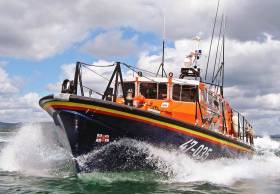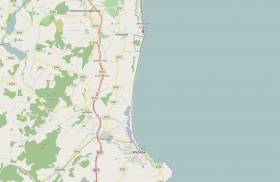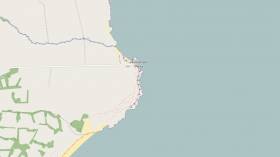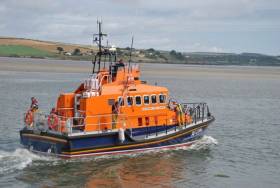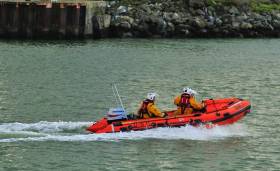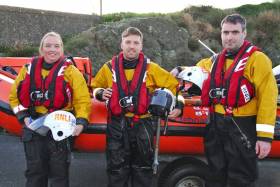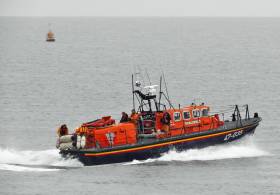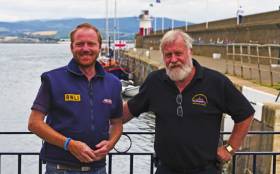Displaying items by tag: Wicklow
Wicklow Lifeboat Assists Fisherman Adrift Near Kiloughter Beach
#RNLI - Wicklow RNLI's all-weather lifeboat launched at 10.52am yesterday morning (Saturday 29 April) to search the bay for a missing fisherman.
The lifeboat, under the command of coxswain Nick Keogh with a volunteer crew, proceeded north to the fisherman’s last known position.
Weather conditions in the area at the time were described as moderate seas with a south-easterly Force 4 wind.
Twelve minutes after launching, the lifeboat crew located the man in his small boat near Kiloughter beach, in what Keogh described as “choppy” seas.
A quick assessment found he was unable to get back to Wicklow Harbour due to mechanical problems with the outboard engine.
The boat was taken in tow back to the garbour, where the fisherman was landed safely ashore just before midday.
“We were happy to assist him,” Keogh added.
Emergency Repairs On East Coast Rail Line After Storm Angus Erosion
#CoastalNotes - Coastal defences in Wicklow suffered significant damage during last week’s Storm Angus, posing a renewed threat to the East Coast rail line, as The Irish Times reports.
The Irish Sea came within metres of the busy Dublin-Wexford line in parts between Newcastle and Wicklow town after erosion from high tides powered by Force 10 winds in the first winter storm of the 2016-17 season.
The same extreme conditions saw a Stena Line ferry stranded outside Fishguard, unable to dock in the Welsh port for more than 24 hours after sailing from Rosslare last Tuesday morning (22 November).
Damage is said to be most severe in Co Wicklow close to where extensive repairs were carried out this past January, with rock armour placed on the adjacent beach at the Murrough, a Natura 2000-designated wetland that’s the largest of its kind on the East Coast.
Further rock armour and steel piling is now being placed at Greystones going south to Kilcoole to protect that stretch of the line after the storm displaced a significant amount of sand, as Iarnród Éireann declared “emergency intervention was required immediately” to save the rail line from future incursion by the sea.
The Irish Times has more on the story HERE.
Search Resumes For Missing Fisherman Off Wicklow-Wexford Border
#Missing - The search was set to resume this morning for a fisherman missing after going overboard from a three-man fishing vessel off the Wicklow-Wexford border yesterday morning (Wednesday 16 November).
As The Irish Times reports, RNLI lifeboats from Rosslare and Wicklow were tasked along with the Waterford-based Irish Coast Guard helicopter Rescue 117 and later Rescue 116 from Dublin Airport to the incident some 6km east of Kilmichael Point in Co Wexford.
It's understood that the missing man is in his late 40s or eary 50s, according to BreakingNews.ie.
Wicklow, Courmacsherry Lifeboats Rescue Fishing Boats In Difficulty
#RNLI - RNLI lifeboats from Wicklow and Courtmacsherry have responded to two separate calls from fishing boats in difficulty around the Irish coast in recent days.
A trawler with three fishermen onboard was towed to safety by Wicklow RNLI yesterday morning (Thursday 10 November) after it lost all power 10 miles offshore.
The all-weather lifeboat, under the command of coxswain Nick Keogh and a volunteer crew, launched shortly after 10am and were alongside the stricken fishing vessel 40 minutes later.
The skipper had dropped an anchor, but it had dragged and the vessel had drifted a short distance south with the tide. Conditions in the area had a slight sea state, with northwesterly winds of Force 2-3 and good visibility.
The Naval Service patrol vessel LÉ Orla and the work vessel Wildcat 2 also stood by the trawler as the lifeboat crew established a towline.
The trawler, with three crew on board, was then towed back to Wicklow and brought safely alongside the South Quay at 12.15pm.
The previous evening (Wednesday 9 November), Courtmacsherry RNLI's all-weather lifeboat was called out at 10.15pm to aid a 65ft fishing vessel in difficulty 25 miles south of the Old Head of Kinsale in West Cork.
The lifeboat, under coxswain Sean O'Farrell and a crew of six, launched immediately and located the casualty at 11.25pm. Conditions at sea were reasonable, with winds in the area blowing 26 knots.
The fishing boat, with three people on board had encountered trouble with its power while trawling in the area and required assistance.
On scene, the lifeboat quickly assessed the difficulties and for the next two hours, the lifeboat and stricken vessel proceeded back at low speed to Kinsale, where the boat was safely berthed at 1.45am.
The crew on board Wednesday night’s callout with O'Farrell were mechanic Stewart Russell, Ken Cashman, Donal Young, Ciaran Hurley, Denis Murphy and Conor Tyndall.
Wicklow Lifeboat Assists Drifting Jet Skier
#RNLI - Wicklow RNLI's inshore lifeboat launched shortly after 5pm yesterday evening (Sunday 25 September) to assist a person on a broken-down personal water craft.
The man had set off from Wicklow Harbour and was about a mile offshore when the engine cut out, leaving him adrift and unable to get ashore.
The lifeboat was alongside the casualty within minutes of launching and the crew carried out a quick assessment before towing the craft back into Wicklow Harbour and landing the man safely ashore.
Wicklow Lifeboat Volunteers Assist Lone Sailor & Rescue Man From Water In Weekend Callouts
#RNLI - Lifeboat volunteers with Wicklow RNLI responded to two callouts over the weekend, assisting a lone yachtsman and a person in the water.
The first came on Saturday 17 September as the all-weather lifeboat Annie Blaker launched at 2.55pm to assist a small yacht south of Wicklow harbour.
The vessel, with one person on board, had developed mechanical problems near the horseshoe buoy. With light winds, he was unable make his way back to Wicklow Harbour.
English yacht Amica, which was passing, made contact and attempted to tow the vessel back to Wicklow. However, with the tide against him and strong currents, they were unable to make much headway around Wicklow Head.
The lifeboat, under the command of coxswain Nick Keogh, located the vessel off Wicklow Head and a towline was quickly established. The yacht and the lone sailor were brought safely alongside the East Pier shortly after 3.45pm.
The second callout came yesterday morning (Sunday 18 September) at 6:45am after the Irish Coast Guard received a report of a person in the water at Wicklow Harbour. The inshore lifeboat crew arrived on scene at the South Quay a short time later.
Lifeboat volunteer Ian Thompson entered the water to rescue the casualty, who was disorientated and injured.
Thompson was able to assess and reassure the casualty before bringing him to a nearby ladder and, with the assistance of gardaí, the person was lifted to safety and transferred to a waiting ambulance for medical treatment.
This multi-agency rescue operation involved the the coastguard, Wicklow RNLI, Wicklow Garda and the Wicklow Ambulance Service.
Elsewhere, the body of a man was recovered from the River Lee in Cork city last night hours after a car was reportedly seen entering the water at Kennedy Quay. BreakingNews.ie has more on the story HERE.
Wicklow Lifeboat Assists Yacht In Early Morning Callout
#RNLI - Wicklow RNLI's all-weather lifeboat launched at 5.32am yesterday morning (Wednesday 7 September) after the Irish Coast Guard received a call for assistance from a yacht in difficulties off the Wicklow coast.
The 10m British ketch, with two people on board, was on passage from Cornwall to Scotland when it developed steering problems, and its crew were having difficulty maintaining their course.
The lifeboat crew located the vessel in fog eight miles east of Wicklow Harbour at 6.10am. Conditions in the area had a southwest Force 3 with moderate sea and poor visibility.
The yacht was taken in tow back to Wicklow Harbour and was secured safely alongside the south quay at 7.45am.
Wicklow Lifeboat Assists Whelk Trawler In Morning Callout
#RNLI - Wicklow's all-weather lifeboat Annie Blaker launched at 7.30am yesterday morning (Saturday 3 September) to assist a fishing vessel four miles offshore.
The RNLI lifeboat, under the command of coxswain Nick Keogh, was alongside the stricken vessel 18 minutes after launching.
After a quick assessment, the 12m whelk trawler with three crew was found to have gearbox failure and unable to motor back to port.
Weather conditions in the area at the time saw a sea state slight with rain and fair visibility.
Once a towline was established, the trawler was taken back to Wicklow Harbour, where the volunteer crew secured the fishing vessel safely alongside the south quay by 8.40am.
#RNLI - Two members of Wicklow Lifeboat Station have received awards from the RNLI in recognition of their dedication and service over the years.
Deputy second coxswain Dave O’Leary has been awarded the crewman’s Long Service Badge for meritorious service to the RNLI.
O'Leary joined the volunteer crew in May 1996 and was appointed an inshore lifeboat helm in 2002. He was put on the coxswains plan in 2007 and became a deputy second coxswain in 2008, the year his sister Lisa became third mechanic.
In 2010, he took over and overhauled the inshore lifeboat crew training plan, and he is now an integral part of the station personnel.
Meanwhile, lifeboat operations manager Des Davitt was awarded inscribed binoculars for his service to the RNLI.
Davitt joined the RNLI Wicklow committee in 1993, becoming vice chairman in 1995 and taking charge of all fundraising for the branch with support from the Ladies Guild.
Davitt was chairman of the appeal committee who raised funds for the provision of a new inshore lifeboat and an extension to the boathouse to house the new lifeboat in 1996.
In 2001, he was awarded the bronze badge for his services to fundraising. Three years later, he took over the new position of lifeboat operations manager – formerly honorary secretary – from the retiring Kevin Desmond.
Fundraising then became separate from operations and Phylis Whyte took over the running of all fundraising activities.
As lifeboat operations manager, Davitt is responsible for all operational activities at the station and authorises the launch of the boat when a launch request is received from the Irish Coast Guard.
Wicklow Lifeboats Launch To Capsized Laser Off Greystones
#RNLI - Both Wicklow RNLI lifeboats launched on Monday afternoon (Monday 18 July) after the Irish Coast Guard received a report of a capsized boat drifting off Greystones.
The inshore lifeboat was first on scene and located the upturned Laser yacht, drifting south of Greystones Harbour.
The crew began an immediate search of the area in case there might be casualties in the water.
Weather conditions in the area were described as wind direction south Force 4 with a moderate sea state, and visibility was good.
During the search by both lifeboats, a call was received from the coastguard to say two people had been taken from the capsized boat by a sailing club tender and were landed safely at Greystones.
The tender then made its way back out to recover the overturned yacht. The inshore lifeboat crew assisted with righting the capsized boat and escorted the tender and the Laser yacht into Greystones before returning to Wicklow.



























